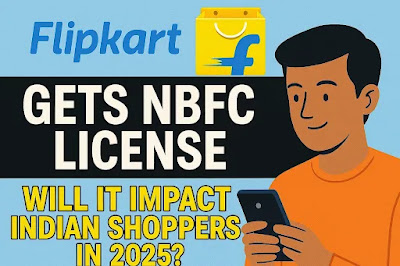🚀 A New Chapter in Indian E‑Commerce
In a bold and transformative move, Flipkart – India’s largest e‑commerce platform owned by Walmart – has become the first e-commerce company to secure an NBFC (Non‑Banking Financial Company) license from the Reserve Bank of India (RBI). Granted under its wholly‑owned subsidiary Flipkart Finance Private Limited on March 13, 2025, this license empowers Flipkart to lend money to consumers and sellers directly, without depending on third‑party lenders .
Previously, Flipkart’s financial credit and BNPL (Buy‑Now‑Pay‑Later) offerings were managed through partnerships with Axis Bank, IDFC First, and Credit Saison . With this new license, Flipkart shifts towards a more profitable in‑house lending model, capturing full credit margins and unlocking vast fin‑tech potential .
📦 What the License Enables Flipkart to Do
This NBFC license allows Flipkart to:
- Offer EMIs and BNPL plans directly at checkout
- Disburse personal and purchase loans via the app super.money
- Extend credit lines to its 35 million+ sellers
- Expand into other lending products like working capital loans, small-ticket personal loans, and possibly even insurance bundling
- Importantly, Flipkart cannot take deposits like a bank — but it can borrow in the financial markets, issue debentures, or co‑lend with banks to finance loans.
💡 What This Means for You — The Shopper
1. Instant Credit at Checkout
Expect “Buy Now, Pay Later” options and flexible EMIs on smartphones, appliances, travel bookings, and groceries — all without third‑party app downloads.
2. Competitive Interest Rates
Direct lending enables customized interest rates based on factors like creditworthiness, order frequency, and shopping patterns.
3. Loyalty-Coupled Credit
Flipkart can combine lending with its loyalty programs (SuperCoins, Vouchers), offering perks linked to credit behavior.
4. Simplified Experience for First-Time Borrowers
KYC verification tied to shopping history and app usage may streamline onboarding, making small‑value loans easier for new-to-credit users.
📈 Impact on Sellers & the Flipkart Ecosystem
Flipkart’s edge isn’t just on the consumer side. With seller financing, it can:
- Provide working capital loans to sellers quickly
- Encourage vendors to invest more in inventory, marketing, and supply chain
- Drive vendor loyalty and compact competition, as sellers stay within Flipkart’s ecosystem
- This ecosystem-first approach resembles Alibaba and Tencent in China, which grew enormously by integrating lending and financial services into retail platforms .
📊 A Strategic Profit Move
Previously, Flipkart shared loan margins with lending partners. Now:
- It retains the full margin, boosting profitability
- Margins on unsecured consumer loans average 10–20%, making this a potential new revenue stream
- The lending market in India for unsecured loans is forecast to grow at 14% annually, aiming to hit $100 billion by 2027
As Flipkart gears up for an IPO, this adds a premium revenue vertical plus an attractive narrative for investors
🌐 Competitive Landscape: Flipkart vs Amazon
Flipkart’s move puts it ahead of Amazon India. Though Amazon acquired NBFC Axio, that license is still pending RBI approval . By securing its NBFC license first, Flipkart:
- Gains a first‑mover advantage in direct lending via e‑commerce
- Creates additional stickiness with both consumers and sellers
- Differentiates its credit offering from Amazon’s delayed rollout
🛡️ Regulatory & Execution Challenges
While the opportunity is massive, the risks are real:
1. Compliance & Governance
RBI regulations require robust KYC, risk assessment frameworks, and transparent interest disclosures. License conditions must be fully met .
2. Credit Risk Management
Digital lending carries risks of default — Flipkart will need to build predictive algorithms using transaction history and shopping behavior.
3. Capital Efficiency
Forcing Flipkart to raise capital or co‑lend in structured formats is key for scalability and risk diversification .
4. Competition Pressure
Players like Amazon‑Axio, Reliance, Paytm, and PhonePe are building similar financial services — competition is fierce.
📅 Timeline: Rolling Out the Lending Services
March 13, 2025: NBFC license approval granted
Mid‑2025: Flipkart to appoint key leadership, finalize business plans and launch app-based lending
Late‑2025: Marketplace lending to sellers begins, combining retail and financial services
2026 and beyond: Expansion into offerings like credit cards, micro‑insurance, salary-advance products
🎯 What You Should Do as a Shopper
- Stay ready for EMI and BNPL options at checkout — helpful for expensive purchases
- Complete KYC in super.money or Flipkart app to enable credit
- Use credit wisely – always check interest rates and hidden charges
- Look out for cashback, no-cost EMI deals linked to credit use
🧭 The Long-Term Payoff
Flipkart's integration of financial and retail services is massive:
For consumers: easier credit, smarter rewards, loyalty integration
For sellers: more working capital, faster growth, and deeper platform dependency
For Flipkart: stronger margins, improved retention, and greater cross-platform control
If executed smartly, this move could elevate Flipkart from a retail titan to a full-fledged consumer lender with global influence, akin to China’s Ant or [Tencent].
🔍 Expert Opinions & Sources
- Reuters (June 5, 2025): “Walmart's Flipkart ... secured a lending licence ... more lucrative model”
- The Economic Times (June 5, 2025): “Flipkart to begin lending from own books”
- FT—Asia Briefing (Jun 10, 2025): Highlights retail players entering lending with synergies and compliance risk
- Think‑tank AInvest Analysis: NBFC license to expand margins and ecosystem dominance
📌 Your Smart Tips:
Flipkart gaining its NBFC license in March 2025 is arguably the most significant strategic shift in Indian e‑commerce of the year. It’s a direct leap into fintech by the largest player in India’s retail space. This integration of shopping and lending reflects the global trend of retail-fintech convergence—and places Flipkart at the front of the line, especially ahead of Amazon.
Expect to see EMIs, BNPL, seller loans, and eventually micro-insurance and credit products under its banner. That convenience may come at a cost—be sure to evaluate interest, read the fine print, but also enjoy the benefits.
India’s consumers are entering a new era. Flipkart is not just evolving—it’s reinventing the way India pays, shops, and borrows.
👇Want to explore more? Check out these articles:








0 Comments